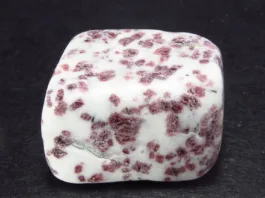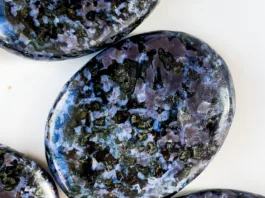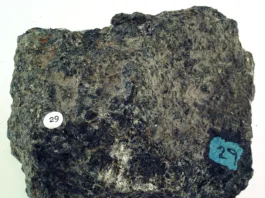Anorthosite is a type of igneous rock that is primarily composed of a mineral called plagioclase feldspar. It is known for its distinctive light-colored appearance, often characterized by a white to light gray coloration. Anorthosites are an important rock type in the field of geology due to their unique composition and geological significance.



Composition of Anorthosite:
The key mineral in anorthosite is plagioclase feldspar, which makes up more than 90% of the rock’s composition. Plagioclase feldspar is a silicate mineral that can vary in composition between sodium-rich and calcium-rich varieties. Anorthosite typically contains calcium-rich plagioclase feldspar, specifically a variety called labradorite. This mineral gives anorthosite its light color.
While plagioclase feldspar dominates anorthosite, other minerals might also be present in smaller amounts. These can include pyroxenes, amphiboles, and even olivine. However, the presence of these accessory minerals is relatively limited compared to the overwhelming dominance of plagioclase feldspar.
Geological Context and Occurrence:
Anorthosites are primarily associated with specific geological settings, particularly those involving the process of magmatic differentiation. Magmatic differentiation refers to the separation and concentration of different minerals within a cooling magma body as it solidifies. Anorthosites are often associated with large plutonic bodies known as anorthosite complexes or massifs.
These anorthosite complexes typically form deep within the Earth’s crust during the early stages of the solidification of a molten magma chamber. As the magma cools and crystallizes, minerals begin to segregate based on their densities and chemical compositions. This can lead to the concentration of plagioclase feldspar, ultimately resulting in the formation of anorthosite.
Anorthosite complexes are commonly found in regions with a history of tectonic activity, such as rift zones or continental collision zones. They can also be associated with certain types of igneous activity, such as the formation of anorthosite plutons within larger intrusive bodies.
One well-known example of anorthosite occurrence is the Adirondack Mountains in New York State, USA, where extensive anorthosite intrusions are found. Additionally, anorthosite complexes have been identified on the Moon, particularly in the lunar highlands. These lunar anorthosites provide valuable insights into the Moon’s early history and magmatic processes.
In summary, anorthosite is an igneous rock primarily composed of calcium-rich plagioclase feldspar. It is commonly associated with magmatic differentiation processes and often forms in the early stages of solidification within the Earth’s crust. Anorthosite complexes are found in various geological settings and offer insights into both terrestrial and lunar geology.
Contents
Mineralogy and Composition of Anorthosite

Dominant Minerals: As mentioned earlier, anorthosite is primarily composed of plagioclase feldspar, specifically the calcium-rich variety known as labradorite. This mineral typically makes up more than 90% of the rock’s composition. While plagioclase feldspar is the dominant mineral, other minerals can also be present, though in smaller amounts.
Accessory Minerals: The accessory minerals found in anorthosite can include pyroxenes, amphiboles, and olivine. These minerals are often present in relatively minor proportions compared to plagioclase feldspar. Pyroxenes commonly found in anorthosite include augite and hypersthene, while amphiboles might include hornblende. Olivine, though less common, can also be present in some anorthosite varieties.
Anorthosite Classification Based on Mineral Composition:
Anorthosites can be classified based on their mineral composition and the relative proportions of plagioclase feldspar and other accessory minerals. One common classification scheme is based on the Anorthite (An) content of the plagioclase feldspar, which is a measure of the calcium content within the feldspar. Anorthite content can range from An0 (sodium-rich) to An100 (calcium-rich).
Anorthosite Variations and Their Significance:
The variations in mineral ratios within anorthosites can provide important insights into the geological processes that led to their formation. Here are some significant variations and their implications:
- Plagioclase-to-Pyroxene Ratios: In some anorthosites, the plagioclase-to-pyroxene ratio might be relatively high, indicating a more evolved magmatic system. This suggests that significant crystallization and differentiation have occurred, with plagioclase preferentially crystallizing earlier than pyroxenes.
- Anorthite Content: The An content of the plagioclase feldspar can reveal information about the composition of the original magma. Higher An contents suggest a more calcium-rich magma source, potentially originating from deeper within the Earth’s crust. Lower An contents suggest a more sodium-rich source.
- Olivine Presence: The presence of olivine in anorthosite can be indicative of certain geological processes, such as interaction with mantle-derived magmas. Olivine is not a common mineral in anorthosites, so its presence can imply mixing or contamination of magmas from different sources.
- Amphibole Occurrence: The presence of amphiboles in anorthosites can suggest late-stage crystallization or hydrothermal alteration. Amphiboles form under specific temperature and pressure conditions, and their presence might indicate post-magmatic processes.
Overall, variations in mineral ratios and compositions within anorthosites provide valuable clues about the formation history of these rocks. They can help geologists reconstruct the magmatic processes, cooling histories, and potential interactions that shaped these unique igneous rocks.
Formation and Petrogenesis of Anorthosite

Anorthosites form through a combination of magmatic differentiation and the crystallization of magma. These processes take place within the Earth’s crust and are responsible for producing the unique mineral composition and appearance of anorthosite rocks.
Origin Theories: Magmatic Differentiation and Crystallization from Magma:
- Magmatic Differentiation: Anorthosites are often associated with the process of magmatic differentiation. This process occurs when a parent magma, which is initially homogeneous in composition, undergoes fractional crystallization. As the magma cools and solidifies, certain minerals (like plagioclase feldspar) crystallize and separate from the melt. This leads to the formation of more evolved magmas with different mineral compositions.
- Crystallization from Magma: Anorthosites can also form through the direct crystallization of magma that is enriched in plagioclase feldspar. In this scenario, the magma cools and solidifies, and the plagioclase feldspar crystals begin to grow and accumulate, eventually dominating the rock’s composition.
Role of Anorthosite in the Differentiation of Parent Magmas:
Anorthosites play a significant role in the differentiation of parent magmas. Plagioclase feldspar, the dominant mineral in anorthosites, tends to crystallize early during the cooling of a magma chamber due to its relatively high melting point. As plagioclase crystals settle and accumulate, they can become a major component of the solidified rock. This process removes plagioclase-rich material from the remaining melt, causing the residual magma to become enriched in other minerals and elements. This evolving magma can give rise to other rock types, such as gabbros and peridotites, which have different mineral compositions than anorthosites.
Processes Leading to the Formation of Anorthosite Plutons:
Anorthosite plutons, which are large, intrusive bodies of anorthosite rock, form through a sequence of geological events. Here are the key steps in the formation of anorthosite plutons:
- Magma Generation: The initial step involves the generation of a magma within the Earth’s mantle or lower crust. The composition of this magma will determine the eventual mineral content of the anorthosite.
- Magma Ascent and Intrusion: The magma begins to ascend through the crust, driven by buoyancy and tectonic forces. As it rises, it can intrude into existing rock formations or create its own intrusion by forcing its way into the crust.
- Magma Solidification: As the magma intrudes into the crust, it loses heat to the surrounding rocks. This causes the magma to cool and crystallize. Plagioclase feldspar crystals, being an early-crystallizing mineral, start to form and accumulate.
- Separation and Accumulation: Plagioclase crystals, being denser than the remaining melt, tend to settle towards the bottom of the magma chamber. Over time, these crystals accumulate, forming thick layers of plagioclase-rich material.
- Continued Differentiation: As plagioclase crystallization progresses, the composition of the remaining melt changes. This can lead to the formation of more evolved magmas and other rock types.
- Solidification of Anorthosite: Eventually, the entire magma chamber cools and solidifies. The accumulated plagioclase feldspar dominates the rock’s composition, resulting in the formation of anorthosite.
In summary, anorthosites are formed through magmatic differentiation and the crystallization of magma. They play a crucial role in the differentiation of parent magmas by removing plagioclase-rich material from the remaining melt. The formation of anorthosite plutons involves the ascent, intrusion, and cooling of magma, leading to the accumulation of plagioclase feldspar and the eventual solidification of the rock.
Geologic Occurrence of Anorthosite

Anorthosite intrusions can be found within various rock types and geological settings. These intrusions often have distinctive relationships with their host rocks, providing insights into the geological processes that led to their formation.
Intrusions Within Various Rock Types:
- Gneisses and Schists: Anorthosite intrusions can occur within metamorphic rocks such as gneisses and schists. These intrusions often appear as lenses or layers within the foliated texture of the host rock. The contact between the anorthosite intrusion and the surrounding rock can exhibit varying degrees of metamorphism and alteration.
- Granites and Syenites: Anorthosite intrusions can be found within larger plutonic bodies like granites and syenites. In such cases, anorthosite layers might appear as distinct bands within the overall composition of the pluton. The contact between anorthosite and these igneous rocks can provide clues about the timing of intrusion and the interactions between magmas of different compositions.
- Basaltic Rocks: In some instances, anorthosite intrusions can be found within volcanic and volcaniclastic rocks, including basalts. This association can provide evidence of the complex interactions between different types of magmas during volcanic activity.
Global Distribution of Anorthosite Occurrences:
Anorthosite occurrences are widespread and can be found on multiple continents. Some notable locations include:
- Adirondack Mountains, USA: The Adirondack region in New York State is known for extensive anorthosite intrusions. The Marcy Massif, for example, contains layers of anorthosite within its complex geology.
- Grenville Province, Canada: The Grenville Province, spanning parts of Canada and the United States, contains various anorthosite complexes. These are associated with the Grenville Orogeny, a significant tectonic event.
- Labrador Trough, Canada: This region hosts large anorthosite bodies, including the famous “Labradorite Big Island” which contains extensive anorthosite layers.
- Fen Complex, Norway: The Fen Complex in Norway is a well-studied anorthosite intrusion that provides insights into the processes of magmatic differentiation.
- Lunar Highlands: Anorthosites are also found on the Moon, particularly in the lunar highlands. These lunar anorthosites offer valuable information about the Moon’s early history and magmatic processes.
Relationship with Other Rock Formations:
Anorthosite intrusions are often part of larger geological contexts and can have significant relationships with other rock formations:
- Mafic-Ultramafic Complexes: Anorthosites are sometimes associated with mafic-ultramafic complexes where the cooling of a magma body results in the formation of layered intrusions. In these contexts, anorthosites might be found along with rocks like gabbros and peridotites.
- Metamorphic Terranes: Anorthosites can be incorporated into metamorphic terranes through tectonic processes. They might experience metamorphism and deformation along with the surrounding rocks, leading to complex structural relationships.
- Tectonic Settings: The occurrence of anorthosites can provide information about the tectonic history of a region. For instance, their presence in rift zones or continental collision zones can indicate specific tectonic processes.
In summary, anorthosite intrusions can be found within various rock types, and they are distributed globally across different continents. These occurrences provide insights into geological processes, tectonic events, and the complex relationships between different rock formations within the Earth’s crust.
Economic Significance of Anorthosite

Anorthosite’s unique composition, appearance, and durability have led to its economic importance in various applications, ranging from building materials to industrial uses.
1. Building Material and Construction:
Anorthosite’s light color, attractive appearance, and durability make it a potential candidate for use in construction and building materials. Its use can add an aesthetic value to architectural projects. The rock’s hardness and resistance to weathering can contribute to the longevity of structures, making it suitable for both indoor and outdoor applications.
2. Decorative Stones:
Anorthosite can be polished to achieve a smooth and lustrous surface, making it desirable for use in decorative stones, countertops, and interior design elements. Its light color and potential for interesting patterns add to its appeal in decorative applications.
3. Industrial Applications:
Anorthosite’s high-temperature resistance and refractory properties make it valuable in various industrial applications:
- Refractories: Anorthosite’s resistance to heat and chemical corrosion makes it suitable for use in refractory linings in furnaces, kilns, and other high-temperature industrial processes. It can withstand extreme temperatures and harsh conditions.
- Ceramics: The mineral composition of anorthosite can contribute to the production of ceramics and ceramic materials used in industries such as electronics, aerospace, and manufacturing.
- Metal Processing: Anorthosite’s refractory properties can be utilized in metal processing industries for lining furnaces and molds used in metal casting.
4. High-Performance Materials:
Anorthosite’s resistance to thermal shock and its ability to maintain its physical properties at high temperatures make it attractive for high-performance material applications, such as in the aerospace and defense industries.
5. Dimension Stone and Monuments:
Anorthosite’s durability and aesthetic qualities also make it suitable for dimension stone and monumental applications. It has been used for statues, monuments, and gravestones due to its ability to retain its appearance over time.
6. Aggregate and Crushed Stone:
Crushed anorthosite can be used as an aggregate material in construction projects, including road construction and concrete production. Its hardness and durability contribute to the quality of construction materials.
It’s important to note that while anorthosite’s properties make it valuable for these applications, its economic viability can be influenced by factors such as transportation costs, availability, market demand, and competition from alternative materials.
In summary, anorthosite’s appearance, durability, and high-temperature properties have led to its economic significance in various industries, including construction, decorative stones, industrial applications (such as refractories and ceramics), and high-performance materials. Its potential use in building materials and industrial processes showcases the rock’s diverse range of applications in the modern economy.
Economic Significance
1. Construction and Building Materials:
- Anorthosite’s durability and attractive appearance make it suitable for use in construction projects such as flooring, walls, countertops, and decorative facades.
- Its resistance to weathering, abrasion, and impact contributes to its long lifespan in various structural applications.
2. Decorative Stone and Landscaping:
- Polished anorthosite can be used as decorative stone in interior design, exterior landscaping, and architectural accents.
- Its elegant appearance and potential for diverse color variations contribute to its use in both commercial and residential settings.
3. Monuments and Sculptures:
- Anorthosite’s ability to hold fine detail and resist weathering over time make it a suitable material for monuments, sculptures, and artistic installations.
4. Industrial Applications:
- Its refractory properties make anorthosite valuable for lining furnaces, kilns, and other high-temperature industrial processes.
- Anorthosite’s use in ceramics, refractories, and insulation materials contributes to diverse industrial applications.
5. Aerospace and Defense:
- Anorthosite’s resistance to thermal shock and high-temperature performance make it attractive for aerospace applications, including heat shields and components for spacecraft.
6. High-Performance Materials:
- Its ability to maintain structural integrity and withstand extreme conditions makes anorthosite relevant for high-performance materials in engineering and technology fields.
7. Aggregates and Crushed Stone:
- Crushed anorthosite can serve as an aggregate in concrete production, road construction, and other infrastructure projects.
- Its hardness and durability enhance the quality and longevity of construction materials.
8. Research and Exploration:
- The study of anorthosite formations on Earth contributes to a better understanding of geological processes and the Earth’s history.
- Lunar anorthosites have provided insights into the geological evolution of the Moon and its early magmatic activity.
It’s important to consider factors such as mining and extraction costs, environmental regulations, and market demand when evaluating the economic viability of anorthosite-based ventures. Additionally, as technologies and industries evolve, new applications for anorthosite may emerge, further enhancing its economic significance.
Geological Significance of Anorthosite
Anorthosite holds several important geological implications and significance, providing insights into Earth’s history, magmatic processes, and tectonic events:
1. Magmatic Differentiation and Crustal Evolution:
- Anorthosites are products of magmatic differentiation, shedding light on how different minerals segregate and crystallize during the cooling of magma bodies.
- Their presence in intrusive complexes helps researchers understand the chemical evolution of magmas and the role of fractional crystallization in generating diverse rock types.
2. Mantle-Crust Interaction:
- Anorthosites can originate from magmas that interact with the Earth’s mantle, offering clues about the composition and origin of mantle-derived melts.
- Their occurrence in specific tectonic settings can provide insights into the interaction between mantle plumes and the overlying crust.
3. Tectonic Processes:
- The distribution of anorthosite complexes can reflect tectonic events and plate movements throughout geological history.
- Their presence in continental rift zones or collision zones can indicate the type of tectonic activity that shaped a region.
4. Early Earth Conditions:
- The presence of anorthosites in ancient rocks provides information about the conditions prevailing on the early Earth, including the composition of its magmas and the processes responsible for forming the continental crust.
5. Planetary Geology:
- Anorthosites found on the Moon offer insights into lunar magmatic history, revealing details about the Moon’s volcanic activity and crustal formation.
6. Mineral Formation and Stability:
- Anorthosites’ mineral composition and assemblage provide insights into the stability of minerals under different temperature and pressure conditions.
- Their presence and associations can inform our understanding of mineral stability in various geological environments.
7. Geological Mapping and Exploration:
- Anorthosite bodies often have distinct geological features that aid in geological mapping and exploration.
- They can serve as markers for identifying specific geological formations and tectonic boundaries.
8. Geological History Reconstruction:
- The age of anorthosite intrusions, determined through radiometric dating, contributes to our understanding of the timing of geological events, such as volcanic activity, pluton formation, and tectonic movements.
In summary, anorthosite’s geological significance lies in its role as a product of magmatic differentiation, its implications for crustal and mantle processes, its connection to tectonic events, and its ability to provide insights into planetary geology and Earth’s early history. Studying anorthosites helps geologists piece together the complex puzzle of Earth’s geological evolution and provides valuable information about the processes that have shaped our planet.
Anorthosite: Key Points Summary
Anorthosite is an igneous rock primarily composed of calcium-rich plagioclase feldspar, with other minerals like pyroxenes, amphiboles, and olivine present in smaller amounts.
Formation and Petrogenesis:
- Anorthosites form through magmatic differentiation and the crystallization of magma within the Earth’s crust.
- Magmatic differentiation involves the separation of minerals as a magma cools, leading to the enrichment of plagioclase feldspar in anorthosites.
- Anorthosites can intrude into various rock types, including gneisses, schists, granites, and even volcanic rocks.
Geological Occurrence:
- Anorthosite occurrences are found globally, including regions like the Adirondack Mountains (USA), Grenville Province (Canada), and the lunar highlands.
- Anorthosites are associated with different geological settings and tectonic processes, providing insights into Earth’s history and magmatic activity.
Economic Significance:
- Anorthosite has economic value due to its durability, appearance, and high-temperature properties.
- It is used in construction, decorative stones, monuments, refractories, ceramics, aerospace, and high-performance materials.
- Crushed anorthosite serves as aggregate in construction projects.
Geological Significance:
- Anorthosites reveal information about magmatic differentiation, crustal evolution, and mantle-crust interactions.
- Their presence contributes to understanding tectonic processes, early Earth conditions, and planetary geology.
- Anorthosites aid geological mapping, exploration, and reconstruction of Earth’s geological history.
Overall, anorthosite is a significant rock type that offers insights into the complex geological processes that have shaped Earth’s crust, from magmatic differentiation to tectonic events and planetary evolution.






